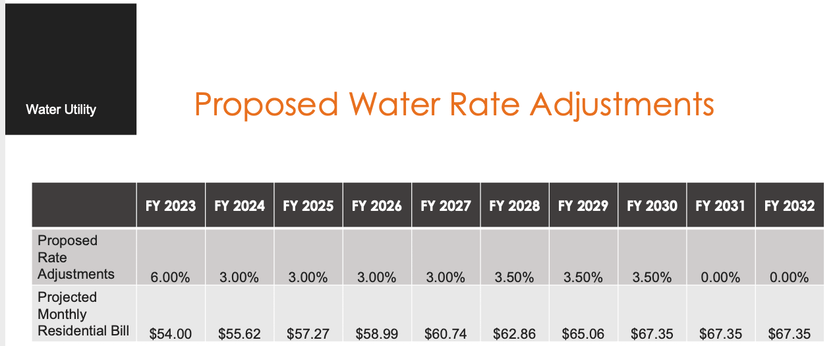As I headed off to the Pagosa Area Water and Sanitation Board meeting yesterday evening, I felt unprepared… even though I believe the PAWSD staff and consultants had every intention of preparing me.
Disclosure: I currently serve on the PAWSD Board of Directors, but this editorial reflects only my own opinions, and not necessarily the opinions of other Board members nor of the Board as a whole.
I had looked over the Stantec powerpoint summary sent to Board members, and had discussed some of the key graphs in a Daily Post editorial on Tuesday morning. But I didn’t understand, yet, how our district could justify the 300% increase in monthly wastewater fees over the next decade, as indicated in one of the charts.

A monthly residential bill of $32.80… increasing to $103?
Yes, we seem to be going through a period of rising costs. Residential rental rates have typically doubled in Archuleta County, for example… and with the increase in property values, many of us are looking forward to increased property taxes. Food prices are up. Local gas stations seem intent on gouging us.
I understand some of the reasons, behind some of the price increases.
But really, folks. Is it truly going to cost three times as much to treat our sewage in 2031?
Apparently so.
The rates increases will be considered for a Board vote in January, so the discussion on Tuesday was somewhat conceptual. Water rate increases got little argument, but then, they were a lot less draconian than the wastewater rate increases. Here’s what Stantec proposed for water rate increases… going from $54 to $67 over the next decade:

Not too bad, really, considering that PAWSD borrowed $38 million for a new water treatment plant on Snowball Road.
But that is just the monthly customers. We also have four additional groups.
1. Folks who live outside the district and use the water fill-stations.
2. Customers who have not yet built on their property but nevertheless pay an ‘availability fee”.
3. Folks who are building a new structure and who will pay a CIF (Capital Investment Fee).
4. Folks who want to include into the district and who pay an Inclusion Fee.
The Board came to a general consensus that the fee increase percentages ought to apply to these other types of customers… except that the CIF, paid by new development, ought to increase by a substantially greater percentage, to account for the fact that the Snowball Plant enlargement is being driven partly by the need to serve future residents, as Pagosa continues to grow.
The suggested CIF would grow from the current $5,353 to $8,958. That’s a 67% increase.
Then we got into the real rate increases:
Wastewater.
The state of Colorado develops policies to ensure that our municipal and industrial uses of water do not end up polluting our rivers and lakes and streams more than is absolutely necessary. One of those policies — Regulation 85 — has caused PAWSD to begin the engineering of a new system that will remove additional nitrogen from our wastewater, before it gets poured out into the environment.

The Reg 85 upgrade is going to cost a bundle. Recent estimates have been in the $5 to $10 million range.
The really expensive upgrade will come along within maybe the next 10 years, due to Regulation 31. This will require a very expensive upgrade to the Vista Wastewater Treatment Plant, perhaps in the $35 million range.
Because the Town of Pagosa Springs will have to pay a share of that prospective upgrade, the Town and PAWSD have recently been discussing a cooperative venture, to build a completely new, state-of-the-art wastewater treatment plant in the South Yamaguchi area. Theoretically, this new plant would solve a couple of big issues: Reg 31, and the problematic uphill sewer line that pumps the town’s sewage to the Vista Plant. Such a cooperative effort would convert the uphill sewer pipeline into a downhill sewer pipeline.
No matter what, the cost of PAWSD wastewater operations are apparently destined to get much more expensive. Who should be paying the bill?
The consensus of the Board last night was, everyone should be paying about the same percentage increase. Except for two groups. New development, and vacation rentals.
The proposal tentatively supported by the Board shows the wastewater CIF paid by new development increasing from $1,179 in 2023… to $16,509 in 2024.
Ouch.
The Board also expressed support for a 40% wastewater surcharge charged to STRs (Short-Term Rentals) based on research by Stantec showing that STRs use about 40% more water than normal residential homes. Board member Glenn Walsh suggested that the surcharge could be more than 40%, if we consider that the average home in Pagosa accommodates maybe two people, creating wastewater… and possibly only during the summer, in the case of second homes.
…while a typical STR accommodates 6 to 12 people, thus creating a larger amount of wastewater. Mr. Walsh estimated that STRs in Archuleta County typically have a 50% occupancy rate.
His idea will be explored further during 2024, sounds like.
As noted in the chart at the top of the page, the Stantec consultants had recommended a sizable wastewater rate increase during 2024 and 2025… from the current $32.80 to $64.29. The Board made several suggestions that might reduce that massive increase for monthly ratepayers, by placing similar percentage increases on other classes of customers.
The PAWSD Board will see updated rate suggestions in December, and will vote on rate increases in January.
Stash some money in your mattress, folks, for upcoming rate increases. The cost of utilities seem to be headed upwards, pretty much across the board.
